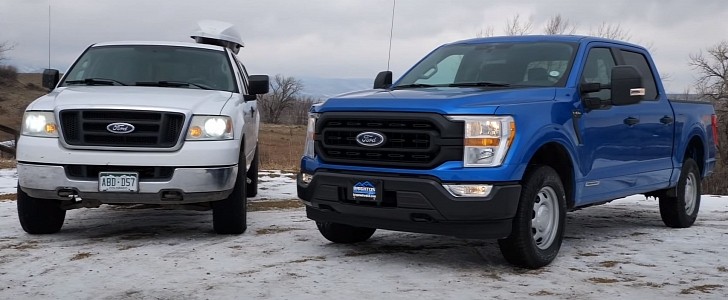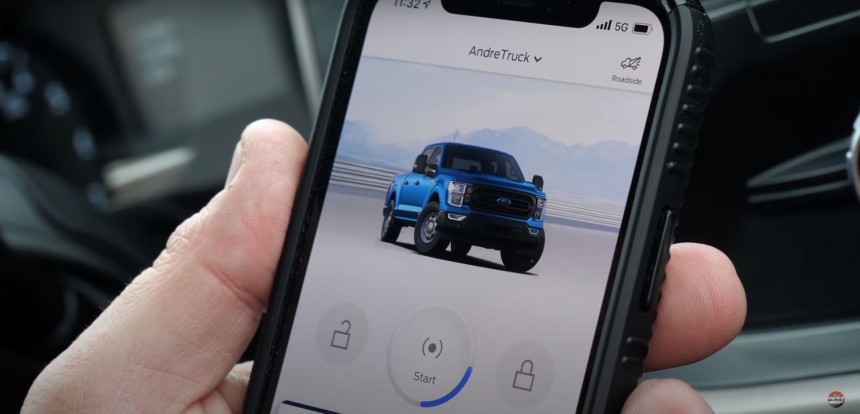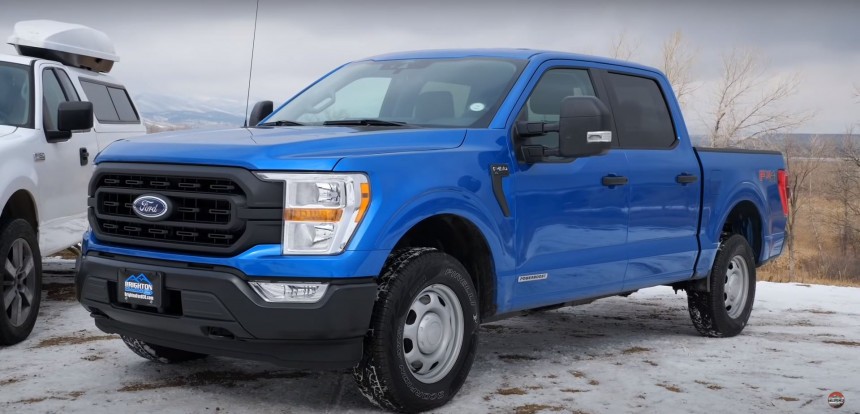Everything changes over time. But living in the present can sometimes have you forgetting how things were like before. So the best way to see how technology has progressed over the years is to do a straightforward comparison. And that's exactly what the guys over at The Fast Lane Truck have done by pitching an old 2004 Ford F-150 against the newest one, the 2021 model.
For this "Old versus New" test, they've brought forth two F-150s, both configured in the same base XL trim. The 2004 version comes in Oxford White while the newer truck is finished in Velocity Blue, and there's a 17-year, $50,000 gap between the two trucks. The 2004 model comes with a V8 engine, and it only cost $3,700, while the 2021 version - a Crew Cab with 4WD, a short bed, and a hybrid V6 engine - was purchased for $51,970.
The old 4.6-liter Triton V8 unit is rated for 231 horsepower and 293 lb-ft (397 Nm) of torque. That works in conjunction with a 4-speed automatic transmission, and this truck also has 4WD, just as the 2021 version does. You already get a sense of how things have evolved just by popping the hood of the newer truck, as you're greeted by the 3.5-liter, twin-turbo V6 unit that harnesses the collective power of gas and electricity, putting out 430 horsepower and 570 lb-ft (772 Nm) of torque. Also, the transmission is now a 10-speed automatic one.
While you can start both trucks using the key fob, as people have been doing for decades, the 2021 model does allow you to forget about the key and "wake up" after direct input from the Ford app on your smartphone. "Did you see that? That's magic," says the reviewer after showing us how it's done. Well, this isn't all that impressive after almost two decades of research and technology development, but still an improvement nonetheless.
Out of the two, the V8 has a chance of sounding better, especially if you're going to opt for an aftermarket exhaust, but in terms of performance and towing capabilities, it's going to be left behind. There's more to be noticed in the gauge cluster, as the 2004 model came with a fairly simple approach, and it didn't even have a tachometer. Fast forward 17 years, and things look a lot better, and you also get more information to work with.
The column shift part of the transmission hasn't changed, but these days it feels more elegant to work with the transfer case, although some people might prefer to old-school approach. The climate controls have also been modernized, and the new truck does provide dual-zone control, which can be voice-activated as well. As with most new vehicles these days, the 2021 version comes with a large screen for the infotainment system, something most people could only dream about back in 2004.
Moving over into the more practical side of things, the 2004 version shown here comes with a long bed that has a maximum payload capacity of 2,000 lbs (907 kg). This truck can also tow up to around 6,600 lbs (2,993 kg). The 2021 version is slightly less capable in terms of maximum payload capacity, but let's not forget this one comes with four doors and a short bed. In the towing department, with more horsepower and torque, the maximum capacity is almost double that of the older F-150.
The EPA rating for the new F-150 is much better, at 24 mpg (9.8 liters per 100 km), while the old model comes in at just 14 mpg (16.8 l/100 km). Would you believe that the 2021 model comes with active aero, allowing for a more efficient flow of air at higher speeds? This is something you'd usually expect to see on a sports car for improved downforce. Big changes have been made in terms of safety features as well, and the new truck is loaded with systems that will aid the driver along the way, including Lane Departure Warning and Blind Spot Monitoring.
After looking at both trucks, the two reviewers now face the ultimate question: "Given these two trucks, and about $50K between them, which would one you buy?" and they also come up with an answer. "I'd rather buy something that doesn't cost $50K, so the 2004 model seems to make more sense. If I put $10K into a truck that cost me $3,700, to make it absolutely perfect, I'm saving a lot of money!" So, at the end of the day, it ultimately comes down to how much you can afford, or at least how much you're willing to spend on your next vehicle.
The old 4.6-liter Triton V8 unit is rated for 231 horsepower and 293 lb-ft (397 Nm) of torque. That works in conjunction with a 4-speed automatic transmission, and this truck also has 4WD, just as the 2021 version does. You already get a sense of how things have evolved just by popping the hood of the newer truck, as you're greeted by the 3.5-liter, twin-turbo V6 unit that harnesses the collective power of gas and electricity, putting out 430 horsepower and 570 lb-ft (772 Nm) of torque. Also, the transmission is now a 10-speed automatic one.
While you can start both trucks using the key fob, as people have been doing for decades, the 2021 model does allow you to forget about the key and "wake up" after direct input from the Ford app on your smartphone. "Did you see that? That's magic," says the reviewer after showing us how it's done. Well, this isn't all that impressive after almost two decades of research and technology development, but still an improvement nonetheless.
The column shift part of the transmission hasn't changed, but these days it feels more elegant to work with the transfer case, although some people might prefer to old-school approach. The climate controls have also been modernized, and the new truck does provide dual-zone control, which can be voice-activated as well. As with most new vehicles these days, the 2021 version comes with a large screen for the infotainment system, something most people could only dream about back in 2004.
Moving over into the more practical side of things, the 2004 version shown here comes with a long bed that has a maximum payload capacity of 2,000 lbs (907 kg). This truck can also tow up to around 6,600 lbs (2,993 kg). The 2021 version is slightly less capable in terms of maximum payload capacity, but let's not forget this one comes with four doors and a short bed. In the towing department, with more horsepower and torque, the maximum capacity is almost double that of the older F-150.
After looking at both trucks, the two reviewers now face the ultimate question: "Given these two trucks, and about $50K between them, which would one you buy?" and they also come up with an answer. "I'd rather buy something that doesn't cost $50K, so the 2004 model seems to make more sense. If I put $10K into a truck that cost me $3,700, to make it absolutely perfect, I'm saving a lot of money!" So, at the end of the day, it ultimately comes down to how much you can afford, or at least how much you're willing to spend on your next vehicle.














